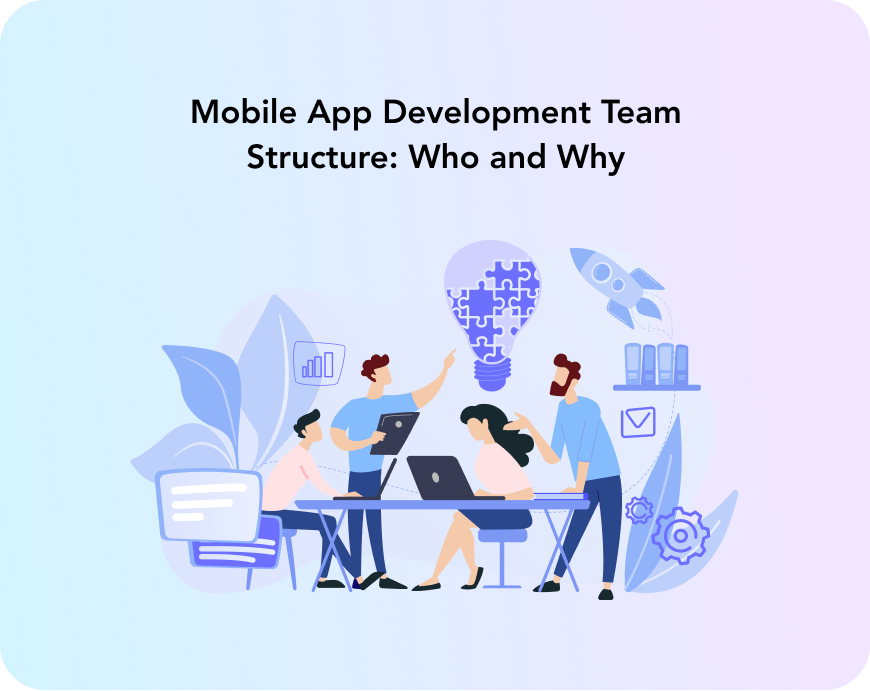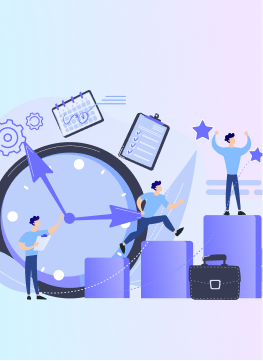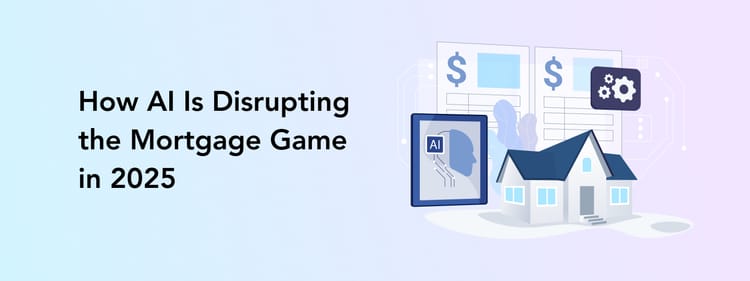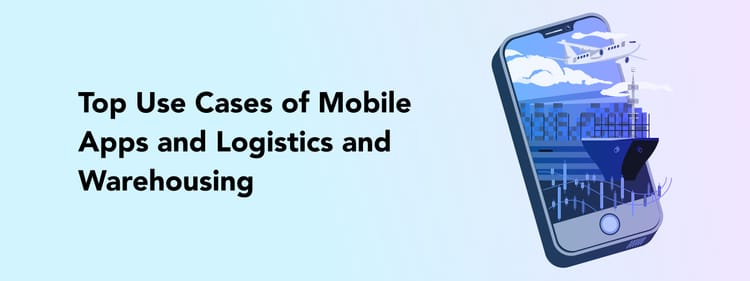A professional and reliable mobile application development team is half of the success when it comes to getting an application for your business. A well-established process involving experienced specialists from each app development area ensures that the final result will match your expectations and meet your business goals. Let’s discuss who are the members of a successful mobile app development team, what are their responsibilities, and how to create a smooth work process.
Which Collaboration Model to Choose
Before we dive right into the structure of mobile app development team, let’s discuss the ways you as an app owner can get your product developed. Usually, the choice of hiring models is between
- Collaborating with freelance specialists
- Hiring an in-house team
- Outsourcing a dedicated team from abroad
- Outstaffing
Each of these models has its pros and cons. For example, collaborating with freelancers means that you can hire highly-skilled professionals to work on one-time tasks. At the same time, you need to dedicate extra time to hiring and managing the specialists, establishing processes between them, ensuring communication, and so on. Additionally, we recommend taking extra time to check the specialists’ reviews and make sure they are reliable and trustworthy.
The same goes for hiring an in-house team. While it gives you a better connection with the team members and more control over the process, it is also a time-consuming and often a rather expensive model to follow as you need to take care of HR, legal, and financial aspects of the work too.
When it comes to outsourcing a dedicated team, most often, this model is more reliable, cost-effective, and time-saving. When collaborating with an outsourcing app development company, you will get a fully-formed dedicated team, who already worked with each other and have all the processes established. Such teams are usually experienced in certain domains and can share expertise among themselves. While a dedicated team doesn’t require extensive management from your side, you are always welcome to engage in the process.
Finally, outstaffing means hiring only certain team members to work on your project based on the time & materials model. An outsourcing company will provide you with specialists based on your requirements. Such a system is similar to working with freelancers but more reliable as a company is responsible for the work outcomes and management side of a matter.
Let’s now discuss the application development organizational structure.
Who Makes Up an App Development Team
Usually, app development team roles and responsibilities include a project manager organizing a consistent process, a UI/UX designer coming up with a clear and eye-catching app design, a developer using the most recent tools to bring the design to life, and a QA engineer checking for any inconsistencies or vulnerabilities.
Additionally, some teams might be enhanced by a product manager or business analyst who is responsible for discovering the app’s strengths, creating a business plan, marketing the product, and so on.
Let’s discuss the responsibilities of each member of a skilled mobile app development team in more detail.
Project manager
A project manager is a link between you, as a product owner, and the team working on the application. Without a project manager, your app development project has all the chances to become, well, quite chaotic. This person is responsible for
- Setting realistic deadlines and project milestones
- Writing out the requirements
- Communicating with the clients, answering their questions, and addressing requests
- Keeping an eye on the project’s progress, reviewing the team’s work
- Setting tasks and deciding on the work scope for the team members
- Resolving any bottlenecks and blocks during the project; adapting the process to possible changes
- Working on the project documentation
- Budget and resource management
- Risk management
- Organizing team meetings and retrospectives
- Motivating the team and taking up the leadership role
- Resolving any conflicts inside the team
A project manager is a person who overlooks the bigger picture while the team members are working on their areas of responsibility. This specialist allows UI/UX designers, developers, and other professionals to focus exclusively on their work while not spending time on the management aspect of the project.
You or your team members don’t have to worry about possible budget issues coming up in the middle of the process or missed deadlines, because a skilled PM will ensure that such issues don’t occur or are resolved in the best and quickest way possible.
Don’t hesitate to ask your project manager virtually anything and give as many details as possible. If there is something bothering you or any problem occurs, address it as soon as possible to minimize the consequences.
UI/UX designer
A UI/UX designer is a specialist who takes your business idea and turns it into a full-scope mobile application. Some bigger teams have separate UX designers (overlooking research, app concept, navigation, and journey map) and UI designers (overlooking the visual aspect). Often enough, if you choose the right UI/UX designer, one specialist can undertake the full cycle of the app design process. More precisely, a UI/UX designer is responsible for:
- Preliminary research (market and competitor research, user persona research, interviews with potential users)
- App concept creation
- Outlining the app’s journey map and user flow
- Creating mockups, low-fidelity, and high-fidelity prototypes
- Working on the app’s branding, color palette, typography
- Communicating with the client to get feedback and adapt the designs accordingly
Mobile app developer
Depending on the platform(s) and development approach of your choice, the number of app development specialists engaged in the process might vary. For example, your business might only require an app for iOS or you might need to reach both iOS and Android platforms.
A mobile app developer can specialize in one of three possible areas.
iOS app development
iOS build solutions that run on Apple’s mobile devices. They create native apps, meaning that they are only suitable for iPhones and cannot be downloaded into an Android smartphone. Hiring an iOS app development team means a high-performance and excellent interface as every code element is written considering the platform’s specifics.
Android app development
Those business owners looking to reach the most popular mobile platform (70% of smartphones run on Android as of 2022!), will need an Android development team. Just like iOS apps run only on iPhones, Android apps are suitable, yes, you guessed it, only on Android smartphones.
If you are planning to present your application on App Store and Play Market both, you can either hire two developers who will each build separate iOS and Android apps or one developer working on a cross-platform solution.
Cross-platform app development
Cross-platform app development is a recently new approach to building mobile apps, yet highly popular due to its effectiveness and cost-optimization possibility. Cross-platform developers can write one source code that runs perfectly fine on both iOS and Android devices. As a result, you only need to get one application to reach both platforms at the same time.
There are several programming languages for cross-platform approach; at Perpetio, we are using Flutter because we can build native-like, speedy apps with this framework while using customizable UI components to closely recreate the native app interface.
Depending on the platform(s) and development approach of your choice, the number of app development specialists engaged in the process might vary. For example, your business might only require an app for iOS or you might need to reach both iOS and Android platforms.
Native App vs. Cross-Platform App: A Choice in Terms of Business Flexibility
Among the responsibilities of a mobile app developer are:
- Implementing all the design elements precisely
- Integrating necessary services and tools, such as in-app payment gateways, video or audio players, maps, databases, and so on
- Communicating with designers and QA specialists to make sure that the app’s look&feel and performance are as expected
QA engineer
Testing is a compulsory part of any app development process and something you shouldn’t try to save money on. Even though sometimes a developer can check their own code for bugs, it is better to assign the job to a specialist in testing. The list of QA engineer’s tasks is quite extensive, including
- Checking the app manually and automatically to detect any functional and non-functional errors
- Tracking the app’s performance (such as load time) as compared to the requirements
- Rating the app’s usability
- Detecting security vulnerabilities
- Documenting and reporting all the issues found
- Communicating with the developer
Mobile App Development Stages and Team Roles
There are several stages of mobile app development, each dedicated to a different process and requiring different specialists. Let’s take a look at which professionals are involved in a winning mobile app development team structure at different stages.
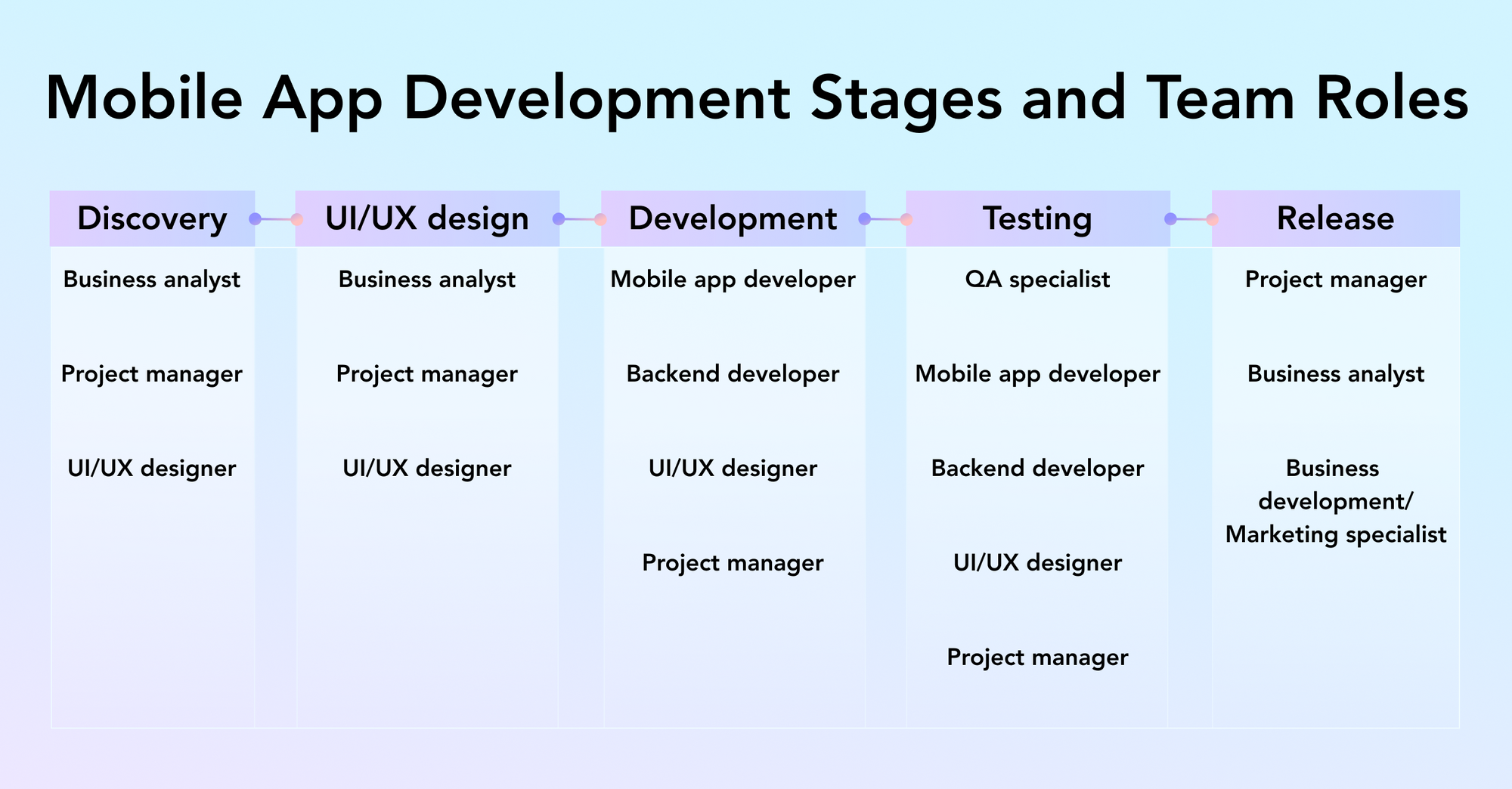
Discovery
The discovery stage is all about exploring your product, finding its competitive advantage, researching the market, and planning the work ahead. To achieve these tasks, you will need:
- A business analyst gathers requirements, conducts market research, and identifies the app's target audience and goals
- A project manager oversees the project, plans timelines and resources, assigns roles and first tasks to the specialists, and ensures effective communication between team members and stakeholders
- A UI/UX designer applies various research methods, such as market research and user persona research, to build a viable app concept
These two professionals will help you kick off the project smoothly and set the ground for future processes.
UI/UX design
The next stage is creating the interface of the application, including both the structure and visual appearance.
- A UI/UX designer creates wireframes, prototypes, and visual designs, focusing on user experience and interface design
- A business analyst assists the designer with feature prioritization, app logic, and monetization implementation as well as makes sure all the previous research is reflected in the final design and the stakeholders’ input is considered
- A project manager overlooks the process and assigns tasks according to the project’s timeline and the specialist’s availability as well as addresses the bottlenecks and mediates between the designer and stakeholders if needed
While the UI/UX designer is the main player in this stage of app development, the business analyst and project manager come as great help for more effective and data-driven work.
Development
Time to implement the UI/UX design! Usually, there are one or two developers working on a project.
- A mobile app developer writes the code for the mobile app, specializing in iOS (Swift/Objective-C), Android (Java/Kotlin), or cross-platform approach (Flutter)
- A backend developer builds and maintains the server-side infrastructure and APIs that support the app
- A UI/UX designer makes sure the interface is being implemented as planned and all the features can be implemented correctly as well as consults a developer on the screens' appearance and functionality
- A project manager helps set realistic deadlines, resolves any hiccups, and organizes regular communication between the client and developers
Depending on your project scale, you might only need a mobile app developer or a backend developer too for creating more complex environments.
Testing
After the last line of code is written, it’s time to make sure there are no issues that can spoil the user experience. The quality assurance princess involves:
- A QA specialist evaluates the app and searches for any technical mistakes, navigation inconsistencies, security vulnerabilities, or any other mistakes that can influence the app’s performance; plus, the tester compares the app against set standards of security, load speed, etc
- A mobile app developer stays in touch with the QA specialist to address any bugs and improve the app
- A UI/UX designer compares the final version of the app to the prototypes and addresses any concerns of the QA specialist about the app's navigation, convenience, and functionality
- A project manager makes sure that all the issues are addressed timely and that there are no bottlenecks both for the tester and the developer
Release
Finally, it’s time to hit the market and upload your application to the App Store or Play Market. Specialists involved in this stage are:
- A project manager is responsible for a smooth launch and sticking to launch deadlines
- Business analyst checks if the final look of the app corresponds with the planned concept, all the features are represented accordingly, and the business goals are achieved
- Marketing or business development specialist works on branding and release strategy to attract the attention of the potential audience
These are all the specialists typically involved in the development process at Perpetio. Depending on your app specifics, there might be more professionals involved, like a product manager, data analyst, or copywriter.

Choosing the Right Team for Your Project
It is a huge challenge to build a high-performing mobile product with an inexperienced and unreliable team. On the opposite, a well-organized and effective mobile app development team structure makes success effortless and the work process pleasant. That’s why choosing your mobile application development team is a step you should give good thought to. Before signing a contract make sure to
- Check the team’s or specialists' reviews online
- Look through the portfolio of previously completed works; search for projects in your domain or using the technologies you prefer
- Hop on a call with a team representative and specialists you are to work with and ask them about their process, collaboration style, and values. Ask about the negative side too: how does the team or specialist handle conflicts or fails?
- Make sure to voice your expectations and requirements beforehand
Remember that projects of different scopes require a different amount of specialists. While for a cross-platform MVP project, one designer and one developer can do all the work, a more complex app development project might require a product manager and two developers (iOS and Android).
Consider Perpetio Your Trusted Partner
While choosing the suitable collaboration model and team scope, you first and foremost should base your decision on your project’s needs and requirements, including its size and budget.
In most cases, a dedicated team is a perfect match for full-cycle app development from scratch. In such a way, you can get a full team of skilled specialists without needing to take care of the management process while still being highly engaged in the process. Usually, such a team will consist of a project manager, UI/UX designer, mobile app developer(s), and a QA specialist.
Perpetio offers both dedicated team and outstaffing app development services. If you are looking for an experienced outsourcing company with a strong portfolio to prove expertise and well-established processes, we are right up your alley.
FAQ
What app development models are out there?
Usually, the choice is between collaborating with freelance specialists, hiring an in-house team, outsourcing a dedicated team from abroad, and outstaffing.
What is a must-have composition of an app development team?
Usually, a development process includes a project manager organizing a consistent process, a UI/UX designer coming up with a clear and eye-catching app design, a developer using the most recent tools to bring the design to life, and a QA engineer checking for any inconsistencies or vulnerabilities.
How to choose a reliable app development team?
Before signing a contract make sure to check the team’s or specialists' reviews online, look through the portfolio of previously completed works, hop on a call with a team representative and specialists you are to work with, and ask them about their process, collaboration style, and values.
